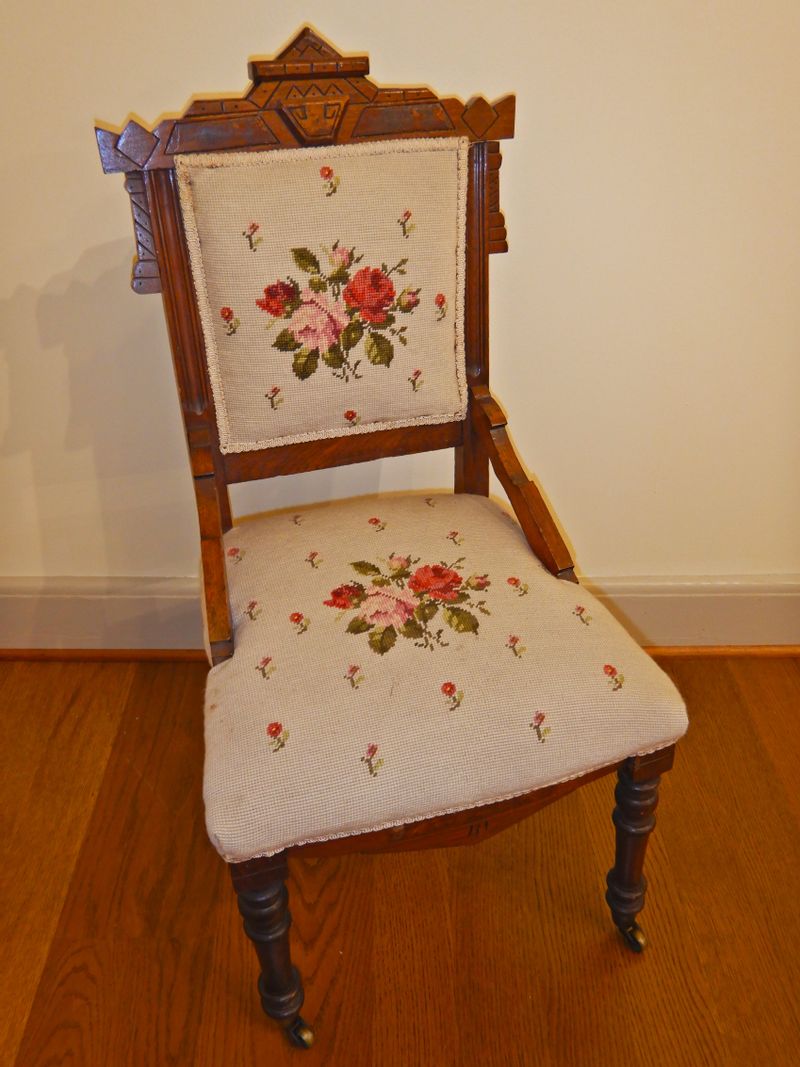A Victorian Needlepoint Chair
By Jubilee P. Reid

Since ancient times, people have found ways to add artistic touches to every type of household item. Needlepoint is one of many embroidery methods used to decorate fabric. Most needlepoint patterns are created by entirely covering select areas of fabric with diagonal stitches. The tent stitch, commonly used to produce beautiful needlepoint designs, was used in Ancient Egypt for constructing tents.
In the 16th century, needlepoint embroidery became a popular decoration on European furniture. One early example is a set of seven chairs in the Bargello, a 13th century residence and prison in Florence, Italy. These chairs feature diagonal geometric needlepoint designs known today as “bargello” after the prison. This pattern has gone in and out of popularity throughout history and is still produced today.
Floral needlepoint embroideries became common in France in the 1730s as the Rocaille (commonly known as Rococo) art period was beginning. The Rococo style came in response to the previously favored ornamentalism of Louis XIV. Rococo designs were often inspired by nature and featured asymmetrical flowers and swirls using soft pastel shades contrary to the heavily gilded designs of Louis XIV. France was highly influential in the art world and French styles spread quickly throughout prominent homes in Western Europe.
The furniture of Victorian England incorporated multiple art styles including Rococo. Dark wood and floral embroideries were common characteristics of this era. Needlepoint was popular in Victorian England; one of Queen Victoria’s daughters, Princess Helena, was the first president of the still-operating Royal School of Needlework.
Needlepoint arrived in North America with the colonists. Martha Washington made numerous skilled pieces in the late 1700s, several of which still exist. Her granddaughter was also a talented embroiderer, as were women enslaved by the Washington family.
Prior to the 1800s, needlepoint was referred to as “canvas work” since it was usually done on cotton or linen canvas to be used on furniture. The size of the yarns used varied depending on the number of holes in the canvas per linear inch. Several different names are used to describe needlepoint depending on the gauge of the canvas. Fine “petit point” was popular as well as the slightly larger “gros point.” The designs were produced using drawings which could be sketched onto the canvas. The nobility often employed professional embroiderers. In the Victorian Era, needlepoint was so popular that many professional embroiderers opened shops and sold pre-made kits as well as other supplies.
An excellent example of Victorian needlepoint furniture is displayed in the Victorian Keith Parlor of the McMinn County Living Heritage Museum. This chair has a dark wooden frame with carved geometric details. The seat and back are each covered with a cream-colored needlepoint cushion featuring a center cluster of red and pink roses and green leaves with smaller flowers scattered around. The pattern on this piece is made with diagonal tent stitches which cover all the base canvas. Even the large amount of solid background around the flowers is comprised of thousands of stitches.
This needlepoint is the size referred to as “gros point.” This type was usually made with two-or four-ply tapestry yarns which were either silk or wool. The embroidery on this chair has 100 stitches per square inch, meaning the total number of stitches is over 40,000. The maker of this piece must have spent many hours sewing and counting stitches to ensure the pattern was completed perfectly.
The embroidered cushion is secured to the frame with small upholstery nails and the edge is covered with cream colored ½ inch wide upholstery trim known as “gimp.” This trim is used to cover the seam of fabric and wood while adding decorative detail. This chair has no armrests and was likely part of a matching set of dining room chairs. It has casters on the front two legs, each with a one-inch diameter wheel. Casters are commonly found on quality furniture of the Victorian Era.
The museum acquired this chair, among other historic items, at a garage sale in 1986. Although the exact age and ownership of this piece is unknown, it likely adorned an elegant parlor or dining room and was used for many a formal gathering.

4.9 (14 Reviews)
McMinn County Living Heritage Museum
522 W Madison Ave
Athens, TN 37303
(423) 745-0329
www.livingheritagemuseum.org
Tue, Wed, Thu, Fri10:00am- 5:00pm
Sat10:00am- 1:00pm

